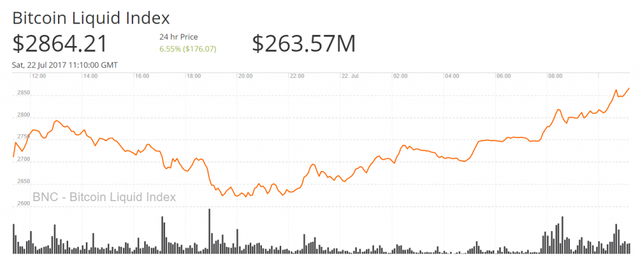Bitcoin Price Breaks $2,860; Segwit Upgrade Finalized Securely
Bitcoin price has surpassed the $2,800 mark on July 22, as the market, investors and traders gained confidence in bitcoin and its ability to scale.
Get exclusive analysis of bitcoin and learn from our trading tutorials. Join Hacked.com for just $39 now.

Initially, the bitcoin mining community led by powerhouse mining pools such as Antpool pushed for the activation of Segwit2x, a solution which activates Segwit and executes a hard fork to increase the block size to 2 MB.
However, as the Bitcoin Core development team along with many analysts noted, the codebase of Segwit2x was not ready and untested until its deadline. Hence, as the last opportunity to avoid a chain split, the mining community agreed to activate BIP 91, a kludge-like solution between the original Segwit proposal BIP 141 and Segwit2x.
Advertisement:
On July 16, when the BIP 91 activation threshold of 80 percent of hash rate was met, bitcoin price increased from $1,850 to $2,350. Investors and traders became certain that Segwit was going to activate via BIP 91.
On July 21, as BIP 91 fully locked in, bitcoin price increased once again from $2,350 to $2,600, demonstrating a staggering $800 increase within a 5-day period.
On July 22, at the time of reporting, bitcoin price has surpassed $2,860, with most indicators pointing toward an optimistic upward momentum for bitcoin price.
Why is Bitcoin Price Continuing to Increase?
Earlier this week, Bitcoin Core developer and well-respected cryptography consultant Peter Todd reminded the community that the lock-in of BIP 91 does not guarantee the activation of Segwit. Todd explained that there existed a 25 percent chance that miners could attempt to renegotiate and fail to signal Bit 1, which is another requirement of the BIP 91 Segwit activation mechanism.
First, miners have to surpass the 80 percent hashrate activation threshold, fully lock-in BIP 91 by signaling it in blocks and then lastly, signal Bit 1 in their blocks to activate Segwit.
“The reason why I think it’s [probability of Segwit not being activated] as high a chance as 25% is because there’s a few ways to renegotiate on segwit with plausible deniability. For instance, miners could “accidentally” mine a bunch of BIP-91 invalid blocks – e.g. claiming it was due to validationless spy-mining – and then decide not to reorganize out those blocks. At that point, the BIP-91 rules have been broken, but lots of transactions depend on them, so the whole thing gets called off with vague mutterings of “we’ll try again once we upgrade our systems” or “well obviously soft-forks are just too dangerous!,” said Todd.
However, Todd’s concerns have become unlikely as BTCC CEO Bobby Lee revealed that 95 percent of miners and their blocks have been signaling Bit 1 and BIP 141. The signaling 141 is also important for the bitcoin market as Todd also emphasized that BIP is the safest method of activating Segwit.
Bobby Lee, the CEO of leading Chinese bitcoin exchange BTCC, revealed that over 95 percent of blocks mined by major mining pools including Antpool, Bitfury, Bitcoin.com F2Poo, ViaBTC and Slush Pool have all signaled for the activation of the Bitcoin Core development team’s transaction malleability fix and scaling solution Segregated Witness (Segwit).
Segwit via BIP 141, Bit 1 and BIP 91, Secure Yet Efficient Scaling